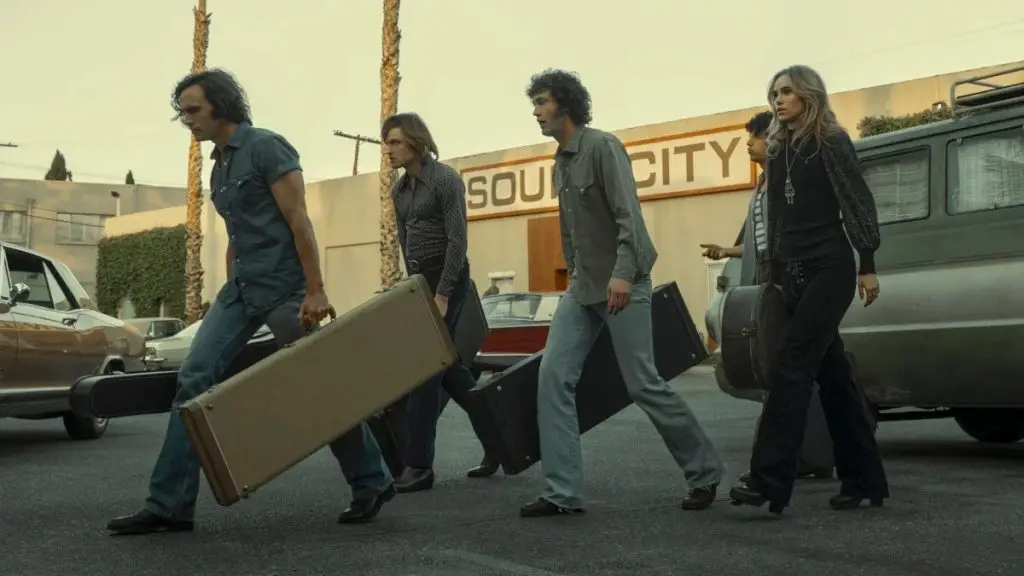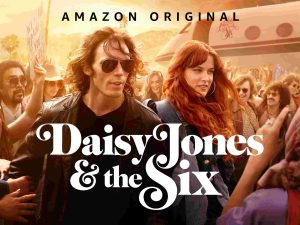The right song, at the right time, with the right person.
Table of Contents
The Essence of Daisy Jones
“The right song, at the right time, with the right person.”
That’s the essence of the story of Daisy Jones and Billy Dunne, the main characters in the bestselling novel, Daisy Jones & The Six by Taylor Jenkins Reid—now a hit series on Amazon Prime. This tale of the rise and fall of a fictional rock and roll band is loosely based on the creative chemistry and romantic entanglements of Fleetwood Mac during the recording of their bestselling Rumours.
Like Fleetwood Mac, The Six, fronted by Daisy Jones, is a hard-driving band of singular performers and singer-songwriters who rise from obscurity to wealth and fame in Los Angeles. It’s the late seventies, a time when the political fervor of the sixties is yielding to an era of hedonism and capitalistic drive, but still carrying vestiges of flower-child influence in its worship of the handmade, the homegrown, and the idealistic.
The Seventies are Back
That naivete may be a thing of the past, but if the marketing around the Amazon series is any indication, the seventies are definitely back. The cast—which includes Riley Keough and Sam Claflin, both totally convincing as decadent, damaged rock stars—has already cut a soundtrack album and is rumored to be considering a tour. The rapidly growing franchise also includes a Daisy Jones-inspired clothing line.
The series has spawned something of an online frenzy that extends to the book, the cast, the music, and the possibility (as yet unconfirmed) of a second season.
The book that inspired it all, Daisy Jones & The Six, was published by Ballantine Books in 2019 and quickly picked up by Reese Witherspoon’s Book Club. Reid, who is also a screenwriter, is the author of eight novels, and Daisy Jones & the Six, her sixth book, won the Goldsboro Books Glass Bell Award in 2020, and was a finalist for Book of the Month’s Book of the Year award in 2021. The audiobook was named Apple’s Books’ Best Audiobooks of 2019.
Early on we meet the Dunne brothers, Billy and his younger brother Graham, raised by a single mother in suburban Pittsburgh. When Billy, a musical talent, is persuaded to sit in with Graham’s garage band, he agrees to be their frontman, and they quickly garner a following. Soon after, Billy meets Camila, a canny girl from a working-class Latino family. When the group goes west to Los Angeles, Camila follows.
The band, still going by their Pittsburg name, The Dunne Brothers, begins booking dates, but when Camila becomes pregnant, she and Billy marry in a Laurel Canyon impromptu wedding. Billy seeks out A&R exec Teddy Price to represent the band, which he does, and soon after, Teddy introduces the band to a protege, Daisy Jones, hoping they’ll collaborate.
It’s an age-old creative equation: The Six needs Daisy to inject the soul and grit they’re missing, and Daisy needs The Six as a marketable vehicle for her poetic, unstructured style. Thrown together in the recording studio, Billy and Daisy clash over working styles, but their creative chemistry is clear, and soon, the hits, as they say, keep coming.
The Mercurial Daisy Jones
This is well-trod romantic territory, two people drawn to each other who start out at loggerheads, and Billy Dunne and Daisy Jones are from the start mired in frictions that make it impossible to work together. And yet, they quickly get under each other’s skin.
Daisy, who’s grown up privileged but neglected (a thread treated more dramatically in the series than in the book) struggles with addiction to alcohol and cocaine. A year earlier, after initial success and a tour, Billy had done a stint in rehab, due to the pressures of stardom and the damage of an absent father, and continues to struggle with sobriety. He’s triggered by Daisy’s drug use, but drawn to her talent, and to her lyrics that mirror his own difficulties, doubts, and fears.
For Daisy, who’s equally drawn to Billy, his marriage, family, and sobriety are technicalities, the kind of bring-downs she considers minor compared to the force of love and a creative soul mate.

Daisy is mercurial, emotionally intelligent, self-destructive, and artistically driven, and Billy, early in their creative relationship, sees the dangers of their collaboration. When he pulls back, Daisy explains, “I was paying the price for the parts of himself that he didn’t like.”
The height of the drama centers on the production of what will be their final, and multi-platinum album, Aurora. As the album’s songs are written, tensions between characters mount—Billy’s conflicted feelings speed Daisy’s spiraling destructive behavior. Their creative connection, and similar flaws and susceptibilities, are the attractions and repulsions at the heart of Reid’s book. As Billy says:
“Everything that made Daisy burn, made me burn. Everything I loved about the world, Daisy loved about the world. Everything I struggled with, Daisy struggled with. But at the same time, we were a mess. Two natural disasters who needed to heal.”
The Aurora tour brings events to their high point, and like all good stories, shows us the occasion for the story—why this story, and why now.
Taylor Jenkins Reid Uses An interview format
In Reid’s novel, the story is told in interviews, with the subjects speaking to an offstage questioner. This lends a colloquial style to the text and an immediacy that might be lost if filtered through a mediated point of view.
And yet, in the course of the story, an unnamed narrator interjects occasional summary—and no spoilers here, but the disclosure of that narrator’s identity at the conclusion is a classic point-of-view reveal and a highly satisfying choice by Reid.
Events come together seamlessly, in a way editor Gordon Lish once compared to a ship being pulled into a bottle, springing up all at once in perfect form.
Fans of the book will find some detail varies between the book and the film adaptation—certain characters are dropped to streamline storytelling, and timelines and locations are altered, but this reader (and series viewer) appreciated the differences and found them complementary. And then there’s the music, astonishing not only for the performances of former non-singers Keough and Claflin, but for the world-building the soundtrack adds to the story. As Reid has said, “It’s a rare adaptation that honors the book in a really lovely way and yet also adds to it…[and] makes interesting changes that make it compelling to engage with this story a second time.”
The series’ documentary approach, its contrast of dramatic scenes with the book’s interview format, balances action with reflection. One other significant change: in Reid’s novel, fifty years pass between past events and the interviews, while in the series, the span is shortened to just twenty years. This leaves the characters a bit younger, perhaps creating an easier leap for the audience, and also opens the possibility of continuing their story—and presenting a second season.
—Lauren Alwan
As an Amazon affiliate, LitStack may earn a commission at no cost to you when you purchase products through our affiliate links.




